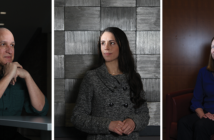The days of “science for science’s sake” are over. Advance-CTR is laying the framework for research that can be translated into therapies, diagnostics, and good public policy.
Jim Padbury, MD, knows he uses too many sports metaphors.
“There’s no I in team.”
“We’re together on the same field.”
“We meet at the 50-yard line.”
These all came out in about 15 minutes. But it wasn’t gratuitous, really; the Patriots fan (and former high school football player) had a point. Just as no one person can bring home the Vince Lombardi trophy, no one institution can land the NIH grant that everyone calls IDeA-CTR (mercifully condensed from Institutional Development Award Program Infrastructure for Clinical and Translational Research).
“We, Brown, wanted to be in the translational research game,” says Padbury, the William and Mary Oh-William and Elsa Zopfi Professor of Pediatrics for Perinatal Research and professor of pediatrics. But the IDeA-CTR is designed to bring institutions together, not compete with one another. “This needed to be not a Brunonian grant but a Rhode Island grant,” he says.
The IDeA program was established by the National Institute of General Medical Sciences in 1993 to build biomedical research capacities in states with historically low levels of NIH funding; just 10 states or groups of states have earned its CTR award. All are coalitions of academic and health care institutions.
Though Brown is the host institution for this infrastructure award, Padbury stresses they’re on equal footing with their five partners: the University of Rhode Island, Care New England, Lifespan, the Providence VA Medical Center, and the Rhode Island Quality Institute.
That collaboration, he says, was “central to our success.” They landed $19.5 million in funding over five years to establish Advance Clinical and Translational Research (Advance-CTR) in 2016, of which Padbury is program director. Right away the group began funding research, providing training and services, and nurturing early career
scientists across Rhode Island.
Now, as they enter year three of the grant, they’re seeing results. Research is already being translated: from lab to market, from bench to bedside, from knowledge to action.
“Translational research” may be one of the latest buzz phrases in science, but it neatly expresses the purpose of medical inquiry since time immemorial. Whether the question is big or small—how does this protein cause disease? does this device improve diagnosis? why do so many people who work here have cancer?—the end goal is to help patients and enhance public health.
But changing the world doesn’t come cheap: it requires funding and job security, mentoring and professional support, data analysis services and training. Advance-CTR makes all of that and more available “to any clinical and translational researcher in the state,” says Helen Leffers, MS, the administrative director of Advance-CTR.
That goes for investigators beyond the program’s six partners, adds communications manager Gabrielle Stranieri. “We really are a hub for resources,” she says.
Already they have funded more than 50 investigators, through their Pilot Project awards, which support collaborations across disciplines and institutions; Mentored Research Awards, which provide protected time and funds for junior researchers; and other programs. Advance-CTR also offers an array of research services in biostatistics and study design, biomedical informatics, and clinical research; and holds classes and workshops at locations across the state on topics ranging from data management to ethical research practices to mentoring training.
But wait, there’s more. “We have also catalyzed more than a dozen successful extramural research awards and one startup company,” Padbury says, pausing for emphasis. “In two years.”
With renewal of the IDeA-CTR award in mind, Leffers believes they’ll be able to report a high return on investment. “Success for us means showing the impact of our awards and services on the Rhode Island research community,” she says. “We want to be able to tell the story of how investigators have been able to advance their research and their career development as a result of our resources.”
Here are a few of those stories.
A Bright Idea
When Eliza Van Reen PhD’07 and Gustavo Fernandes, PhD, teamed up to develop technology that could help sleep-deprived teenagers do better in school, a light bulb went on.
Research by sleep experts like Mary Carskadon, PhD, professor of psychiatry and human behavior, suggests that early school start times undermine adolescents’ academic performance because their natural circadian rhythms keep them up too late to get a good night’s sleep.
In 2014 Carskadon began collaborating with Jimmy Xu, PhD, professor of engineering and of physics, on a dynamic (or “smart”) lighting system for schools that could shift the circadian rhythms of sleepy teens to help them stay awake and, ultimately, improve their grades.
But lots of other people live lives that don’t match up with their internal clocks—shift workers, medical residents, and security guards, among others. Van Reen and Fernandes, the junior researchers on the project, saw an opportunity to scale up. “We thought that our technology could be of broader interest to other groups,” Van Reen writes in an email.
Before they could get to that point, though, they needed a boost. That’s where Advance-CTR’s Pilot Projects Program came in.
When the pair met, Van Reen was an assistant professor of psychiatry and human behavior. She had completed her PhD in Carskadon’s lab and, after postdoctoral training at Harvard Medical School, she returned to Brown to continue her research on health issues related to adolescent sleep. Fernandes, meanwhile, was a postdoctoral researcher in Xu’s lab, working on photonics—technologies that generate and manipulate light, from everyday devices like our phones and TVs to specialty equipment like medical imaging and optical lasers.
Van Reen and Fernandes enjoyed their collaboration and wanted to build on it. “As we approached the final stages of the [school lighting]project, we wanted to further develop the use of sensors along with the circadian targeted light recipes that we had been working on,” Fernandes writes in an email. “We decided that [the Advance-CTR award]would be a good fit as we could leverage some of the resources of the ongoing project, like participants, light systems, etc., and quickly establish proof-of-concept.”
With their Pilot Project award, they did just that. They started talking about commercializing their system and wrote a patent application. The word “startup” crossed their lips.
“The idea of making the leap from academia to startup happened gradually,” Fernandes writes. They sought advice on funding strategies, intellectual property, legal matters, and marketing. “We gave up our academic positions after we talked to investors,” Van Reen said at the annual IDeA Symposium in June. “It’s hard to get money if you have a foot in both doors. People don’t believe you’re committed.”
Van Reen and Fernandes founded Circadian Positioning Systems in Newport in 2017. But they haven’t completely cut the cord with Brown. “We both still talk to our academic mentors all the time,” Van Reen said.
It’s no problem for Advance-CTR that two of their awardees left academia, Leffers says. In fact, they “absolutely” consider it a success. “Our goal is to improve health in Rhode Island,” she says.
Brett Owens, MD, says he isn’t trying to put himself out of business. But if he can find an alternative to the meniscus tear surgery, one of the most common orthopedic procedures, the chief of sports medicine at The Miriam Hospital might have some more free time on his hands.
Owens, a professor of orthopaedics, and Chathuraka Jayasuriya PhD’13, an assistant professor of orthopaedics (research), are using their Pilot Project award from Advance-CTR to investigate whether mesenchymal stem cells, which derive from bone marrow, could be used to repair meniscus tears.
“One of our goals is hopefully to be able to avoid a surgical intervention, and hopefully be able to work just with an injection, potentially, of cells,” Owens says. He’s hedging because their idea is very much unproven right now—but, he adds, “The future is definitely biologic.”
Jayasuriya admits that at first he wasn’t excited about the project. A cartilage biologist, he’d been pursuing the idea of using stem cells to repair cartilage damaged by osteoarthritis (OA). Because meniscal tears are often associated with OA, and vice versa, Owens theorized they could use stem cells to repair them, too. Jayasuriya came around: “If you could try to attenuate [OA] at an early stage by preventing the injury or by healing the initial injury that causes the disease, that might be a unique strategy,” he says.
Allogenic, or donor, stem cells present challenges when transplanted to treat blood diseases or tumors, because native white blood cells identify the foreign cells and destroy them. But the knee joint is a “unique environment,” Owens says, because it doesn’t have a blood supply; nutrients are delivered through the joint fluid. “This is what’s piqued our interest: the potential absence of blood supply could be a mechanism that allows allogeneic tissue to be able to revive and heal in the environment,” he says.
Using stem cells isolated from young, healthy cartilage and menisci, Jayasuriya and Owens say they’ve done proof-of-concept studies and submitted two papers. They have a patent pending on the cells and plan to apply for an NIH Research Project Grant (R01). “The preliminary data, it looks great,” Owens says. “This is a little bit pie in the sky, or a moonshot. But it’s pretty exciting.”
They have recently seen the injectable meniscus therapy work well in human organ culture experiments, Jayasuriya says. “We’ve only scratched the surface. And I think the CTR gave us the opportunity to do that,” he says. “You need to have some sort of funding mechanism that says, ‘hey, I believe that you guys can make it,’ for anything to happen.”
He credits the award for their collaboration, too. “[Owens] does the surgeries, and I do the molecular biology,” Jayasuriya says. “It’s a really nice system that they encourage. I don’t think it really would have been easy without something like that pushing us together.”
Stronger Together
Connecting researchers across disciplines and institutions is one of the chief missions of Advance-CTR. Its first community engagement Pilot Project award brings together not only researchers from Brown and the University of Rhode Island, but also members of the Narragansett Indian Tribe, whose reservation encompasses 1,800 acres in Charlestown, RI.
Two freshwater ponds are the centerpieces of that land, where people fish for bass, perch, pickerel, and other species. But historically the Narragansetts lived on a far larger swath of southern New England,
says Elizabeth Hoover AM’03 PhD’10, Manning Assistant Professor of American Studies at Brown, and they hunted, fished, grew, or traded for all of their own food. Now, she says, with their seriously reduced land base and no shoreline access (“No one wants to share their beachfront property”), fish from the ponds are a critical connection to the tribe’s past food sovereignty.
That’s why testing that found the two ponds are contaminated with mercury and PCBs, a legacy of the state’s industrial past, was so devastating to the tribe, says Hoover, who’s written extensively about food sovereignty and the cultural effects of fish advisories.
“You’ve got this conundrum here,” adds Marcella Thompson, PhD, an assistant professor of nursing at URI. “While you want to protect the public … when tribal peoples don’t eat the fish and don’t go fishing, they lose the language around what the fish are called, they lose their traditional methods of fishing, and they lose that connection to culture and community.”
Thompson, Hoover, and their co-PI, Dinalyn Spears, MS, the tribe’s director of community planning and natural resources, are partnering with the Narragansett tribal government to assess the impacts of the contamination. The collaboration first came about in 2013 when Hoover contacted Spears on behalf of the community engagement arm of Brown’s Superfund Research Program, which she co-leads with Thompson.
“I knew Dinalyn because we’re both fancy shawl dancers,” says Hoover, who has danced at the Narragansetts’ annual powwow. “I asked her, what are things you wished you had the time and resources to work on, and how can we help you get funding and the help you need?”
Preliminary sampling by the EPA several years ago had indicated the fish were contaminated with mercury, and Spears wanted to confirm it. Superfund and other grants covered the tests as well as focus groups, which asked Narragansetts how they used the ponds and what the fish and fishing meant to them, Hoover says. Tribal members helped the researchers catch the fish for analysis and develop community engagement activities for kids and adults, including fishing tournaments, workshops, and art projects.
Thompson says the Advance-CTR Pilot Project award allowed them to develop a fish consumption survey, and is helping with statistical analysis. The project represents a somewhat different type of translational research than the clinical work many CTR awardees are doing, as the team—including the tribe—will translate their findings “into knowledge and education, and then into policy, and then into action,” she says. When the researchers bring their results to the Narragansett leadership, they, and the tribe’s members, will decide what to do next.
“They are a sovereign nation,” Thompson says. “Some of them have said, regardless, because it’s so important to them, they’re going to continue to eat the fish. These will be difficult decisions to make.”
Moving On Up
The main goal of cardiac rehabilitation is just like it sounds: rehabbing your heart. But patients who go through the program—most of whom have had a heart attack or cardiac surgery and are overweight—often make radical lifestyle changes, including exercising more and eating better. Yet after 12 weeks of intensive therapy, they don’t lose much weight.
“One could imagine that that could be really discouraging,” says Carly Goldstein, PhD F’17. “And it makes me wonder about how that affects long-term adherence.”
Goldstein has been studying cardiovascular health and behavior since she was a grad student at Kent State. During her postdoctoral research fellowship in The Miriam Hospital’s Weight Control and Diabetes Research Center, she applied for a career development award (K23) from the National Heart, Lung, and Blood Institute; when she didn’t get it, a colleague forwarded her the call for Advance-CTR applications. In July 2017, she received a Mentored Research Award.
“I was overjoyed,” Goldstein says; she had funding to stay at Brown for another two years. Then came more good news: she’d resubmitted the K23 application, and thanks to the show of support from Advance-CTR, this time the grant came through.
“Our award … makes [trainees]even more competitive for these Ks from NIH,” says Advance-CTR’s program coordinator, Ed Hawrot, PhD P’14, who is also the senior associate dean for biology and the Alva O. Way University Professor of Medical Science at Brown.
“For CTR, [Goldstein’s K23] is a major success because she was able to transition from our local institutional career development award mechanism to an individual, faculty-level award from the NIH that is highly competitive at a national level,” Hawrot adds. “The K23 award provides protected time—three to five years—for intensive training to prepare recipients to conduct NIH-supported, patient-oriented research.”
Now an assistant professor of psychiatry and human behavior (research), Goldstein is trying to tease out which interventions not only best help cardiac rehab patients lose weight, but that they’ll also keep using. Cardiac rehab is “one of the only intensive lifestyle interventions that we have full insurance coverage for,” she points out. “To not have these folks losing weight is a real missed opportunity.”
All of the tools Goldstein will offer in the study have a technology component, from an activity tracker like a FitBit, to a virtual reality game (which she helped develop on another grant) where players decide whether the main character will eat a doughnut at the office or go for a walk. “It’s like a choose-your-own-adventure game,” she says, that will “allow the user to practice the behavioral skills that we’re teaching.” Participants also might attend virtual meetings on topics related to weight loss, including how to make cultural foods more heart healthy. “I’m probably going to do one on eating at your favorite Rhode Island restaurants—how to go to a clam shack and still stay on track,” she says.
Goldstein continues to work closely with her CTR project mentors, and two of them—Professor Rena Wing, PhD, and Associate Professor Graham Thomas, PhD, both in psychiatry and human behavior—tapped her to be co investigator on their study to improve the long-term effectiveness of an online weight loss program.
“Without the CTR,” Goldstein says, “I wouldn’t be able to do something like this, because I wouldn’t have had a faculty position.”




